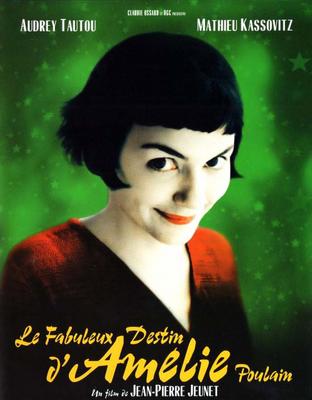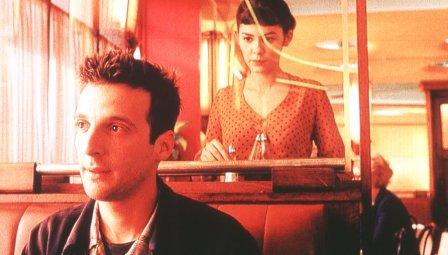For English-speaking audiences, perhaps the best-known and best-loved French film of recent years is Jean-Pierre Jeunet's 'Amélie', released in 2001 in France as 'Le Fabuleux Destin d'Amélie Poulain' ('The Fabulous Destiny Of Amélie Poulain').
 You surely know the scenario by now: in the aftermath of Princess Diana's fatal Paris car crash in 1997, innocent daydreamer Amélie (played by Audrey Tautou) sets out to improve the lives of those around her. But when she falls for the idiosyncratic Nino (Mathieu Kassovitz) she's too shy to take her own chance of happiness.
You surely know the scenario by now: in the aftermath of Princess Diana's fatal Paris car crash in 1997, innocent daydreamer Amélie (played by Audrey Tautou) sets out to improve the lives of those around her. But when she falls for the idiosyncratic Nino (Mathieu Kassovitz) she's too shy to take her own chance of happiness.
In France the movie's old-fashioned optimism captured the country's imagination and added to the buoyant mood created by the national football team's World Cup and European Championship successes. It also pleased conservatives who saw the film as somehow embodying traditional French community values - a dangerous idea to be floating in that Le Pen-marked era. (Ironically, the film was originally written to star Emily Watson and to have much of the action in London. Only because Watson was committed to Robert Altman's 'Gosford Park' was the screenplay reworked and recast with the relatively unknown Tautou. And the interiors were shot in a studio in Cologne, the film being co-produced by a German company.)
Sure enough, there were many French people who didn't see its charms and questioned the popular perception of the film as being representative of the real Paris and France. It emerged that Jeunet had digitally removed from location shots any graffitti, dog turds and other such unwanted street details. Critics questioned the film's racial balance: the only main non-white character is Lucien the much-bullied mentally/physically disabled shop assistant (played by stand-up comic Jamel Debbouze, who really does have a withered right arm like his character), and there's a rather superfluous scene on a train platform where Amélie feels intimidated by a group of black teenage boys. (Ironically again, the male lead in 'Amélie', Kassovitz, directed 'La Haine', that searing portrayal of ethnic tension in suburban France and the other internationally-well-known French movie of the period. It's often considered to be the anti-'Amélie'.)
 It's true that the Paris of 'Amélie' is surprisingly free of street detritus, ethnic groups - and tourists. But the film is clearly meant to be as whimsical and escapist as its title character. When Amélie's bedroom ornaments start discussing her romantic problems while she sleeps, it should be clear that this isn't docudrama or cinema verité.
It's true that the Paris of 'Amélie' is surprisingly free of street detritus, ethnic groups - and tourists. But the film is clearly meant to be as whimsical and escapist as its title character. When Amélie's bedroom ornaments start discussing her romantic problems while she sleeps, it should be clear that this isn't docudrama or cinema verité.
And some others just hated it because they thought it was schmaltz. Fortunately for diabetics in the audience, most hints of saccharine are neutralised by a dark strand of tragicomedy - especially in the flashback to Amélie's childhood (her mother's bizarre death, for instance). The supporting characters all have some touch of sadness or bitterness in their hearts - the failed writer, two jilted lovers, the hypochondriac tobacconist, the fragile old painter and the bar owner who was crippled when her lover literally let her down. And the central couple are unglamorous childlike innocents who seem lost in the nightmare of a cynical modern world, especially in the context of Diana's shocking death - Amélie is timid like a mouse and Nino (the world's most unlikely sex industry employee) keeps a scrapbook collection of ghostly discarded passport photos. It's easy to root for them. One rather touching scene is Amélie's daydream of Nino popping down to the shop and returning to her apartment: it rings true.
The film was released in the USA as 'Amélie From Montmartre' - because Montmartre is where most of the action takes place. Fans can visit the key locations and we believe there's even an 'Amélie' tour of the area. The restaurant-bar, Les Deux Moulins, is a real establishment on rue Lepic - the tobacconist counter was removed a few years ago to make room for more seats but the rest is as it appears in the film. Similarly, the greengrocery is a real shop on rue des Trois Frères. Amélie's metro line is the 12: she encounters a beggar playing records on the platform at Abbesses, while her descriptive tour for the blind man ends at the entrance to Lamarck-Caulincourt. And her trail of arrows leads Nino up the park at the basilica of Sacré-Coeur, now a hugely popular tourist venue since that scene. However, the iconic stone-skimming scene is from Canal Saint-Martin, a few kilometres south-east of Montmartre.
If you've never been to Montmartre, it's on a hill in the north of the city. Its bohemian reputation comes from the fact that artists like Renoir and Picasso and Toulouse-Lautrec lived and worked there. On the southern foot of the hill is Pigalle with its seedy strip clubs and the Moulin Rouge. Abbesses, the hip part, is just up the hill from the Moulin Rouge. Most tourists go towards Sacré-Coeur and Place du Tertre, where modern-day portraitists hope to cash in on Montmartre's association with art. Down the other side are streets like rue Lamarck and rue Caulincourt, with few tourists and a more relaxed and authentic vibe. There's a cemetery in Montmartre: the most famous resident is François Truffaut, thus adding another link between Montmartre and cinema. (Three short clips from 'Jules Et Jim' pop up during 'Amélie'.)
 Like 'La Haine', 'Amélie' is celebrated for its soundtrack - the old-style accordion and classical piano score composed by Yann Tiersen. (Musically too, 'Amélie' and 'La Haine' seem to be conjoined opposites.) Not from Montmartre but from the Breton town of Brest, Tiersen (right) wasn't the first choice to write the film's music - but Michael Nyman, Jeunet's original pick, was unavailable. As with Emily Watson's prior engagement, this was a happy accident for Jeunet - Tiersen's evocative and playful waltzes have contributed hugely to the film's popularity. In particular, the film's theme, 'La Valse d'Amélie', is instantly recognisable.
Like 'La Haine', 'Amélie' is celebrated for its soundtrack - the old-style accordion and classical piano score composed by Yann Tiersen. (Musically too, 'Amélie' and 'La Haine' seem to be conjoined opposites.) Not from Montmartre but from the Breton town of Brest, Tiersen (right) wasn't the first choice to write the film's music - but Michael Nyman, Jeunet's original pick, was unavailable. As with Emily Watson's prior engagement, this was a happy accident for Jeunet - Tiersen's evocative and playful waltzes have contributed hugely to the film's popularity. In particular, the film's theme, 'La Valse d'Amélie', is instantly recognisable.
In fact, the soundtrack to 'Amélie' is the story of two records. Tiersen started writing the film score while already making an album called 'L'Absente', from which he borrowed instrumental passages for his 'Amélie' project. Both records were released in 2001: Tiersen was the golden boy of French music that year.
'L'Absente' is a marvellous album, superior to its sibling. Just as 'La Haine' is the counter-image of 'Amélie', so 'L'Absente' is a darker and sadder take on the romance of the film soundtrack. (The title of 'L'Absente' suggests a female who is missing or gone: we can presume there's no happy ending.) The dominant sounds are glacial pianos (think of Chopin and Satie) and mournful strings, with accordions and toy pianos in supporting roles that are almost taunting in their joie de vivre. The standout track of 'L'Absente' is the melancholic 'La Parade' and its dark, velvety vocals from Lisa Germano.
There's an Irish connection - and, it being sensitive French alternative pop, this can only mean Neil Hannon. Our fellow Francophile sings his own English lyrics to the whirling waltz of 'Les Jours Tristes'. This was the period of Hannon's effort at sounding less whimsical and more heartfelt, and 'Les Jours Tristes' is certainly cut from the same cloth as his writing on The Divine Comedy's 'Regeneration' and Jane Birkin's single 'Home'. The instrumental version of the song is played over the closing credits of 'Amélie', and so Hannon has a writing credit on the film soundtrack too - a rather lucrative little nixer.
Your blogger-to-be was at Tiersen's Dublin concert in Vicar Street in 2003, where the star was backed by a fine Breton indie band called The Married Monk. Hannon didn't appear to sing his song (the lead singer of The Married Monk sang 'Les Jours Tristes' that night), but Tiersen was still captivating to watch. In particular, we were most impressed by how he played the piano and accordion at the same time.
A friend of ours saw Tiersen play at a festival in Spain this summer. Unfortunately, it seems that he has decided to rock out - with excruciating results. Was this a once-off whim or the dreaded 'new direction'? Time will tell: Tiersen's new album is due for release before the end of this year.
You should listen to 'L'Absente' (here in full on Deezer, for instance) and get a complete picture of Tiersen and 'Amélie'. Back to the film and its soundtrack, though - live at La Route du Rock in 2001, here's Yann Tiersen on melodica and piano with 'Le Moulin'.
More ...
[Read more...]